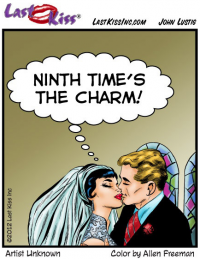Over the last 30 years I’ve lead dozens of teams through strategic planning as a CEO and as an outside facilitator. I’ve learned there are three essential characteristics for a good facilitator.
- Strong listening skills
- A coherent framework
Over the last 30 years I’ve lead dozens of teams through strategic planning as a CEO and as an outside facilitator. I’ve learned there are three essential characteristics for a good facilitator.
In the mid-90’s I had the pleasure of working for a genuine serial entrepreneur (defined as someone capable of having 10 number 1 priorities). He was charming, he was brilliant, and as the company got larger he was a disaster. Eventually the lack of focus caught up with us and the company cratered. It was only saved by a new infusion of capital, paring our development back to a single product line, and several years of patient turnaround work.
Setting priorities and focus for product development is one of the core questions all companies have to wrestle with. The answer determines how resources are focused. It also drives explicit and implicit organizational structure and power. It quite literally defines who you are as a business.
I’ve found that a simple framework with three options is the cleanest way to start this conversation. The three options are all valid, but they have very different strengths and weaknesses. Picking the right one for your company is critical.
In January 2001 as the dot com boom burst online education site wwwrrr.com went out of business overnight, literally. Coverage tended to focus on the employees – who ultimately filed a class action lawsuit for back pay and 401k contributions.
Lost in that ugly coverage was the blunt reality for teachers and schools that the new era of on-line content had a very dark side. Teachers who were relying on wwwrrr’s materials on January 9th were left with absolutely nothing on January 10th. They had no warning.
When schools buy a textbook they own the thing. If the vendor stops offering the book the school still has the thing. With cloud-based solutions schools are buying a license to a service. If the vendor stops offering the service it evaporates. Teachers rightly want some assurance that if they integrate a useful solution into their lesson plans that they can use it for several years.
 One of the hard lessons I’ve learned over my career is that anything worth doing needs to be done several times before you can evaluate it. The Experience Curve as a concept has been with us since 1885, yet many are still unaware of this common sense insight on how people learn and what it means for management decisions.
One of the hard lessons I’ve learned over my career is that anything worth doing needs to be done several times before you can evaluate it. The Experience Curve as a concept has been with us since 1885, yet many are still unaware of this common sense insight on how people learn and what it means for management decisions.
Here are a couple of examples, one from observing schools adopt new curriculum materials and one from my experience as a CEO. Both are relevant to education companies.
New Curriculum Materials
 eBooks, iPads, and the Kindle are changing the fundamental structure of the publishing industry. From a strategic perspective they are having the largest impact on the development and pricing of products. In other words it is affecting the “what” deeply. The “how” has not changed all that much, regardless of whether you are selling print and/or technology.
eBooks, iPads, and the Kindle are changing the fundamental structure of the publishing industry. From a strategic perspective they are having the largest impact on the development and pricing of products. In other words it is affecting the “what” deeply. The “how” has not changed all that much, regardless of whether you are selling print and/or technology.
There are four fundamental strategies for a growing a company in the K12 sector because even in the best of times K12 is (mostly) a zero sum game. In 2008 I wrote a post about this competitive dynamic:
In normal times education budgets grow at 2%-5% a year. Most start-ups or new products need to grow at a huge multiple of that – 30% to 300% or even more. Mathematically in order for you to grow someone else is must lose out.
We are most definitely not living in “normal times” these days. Any growth strategy in today’s market is fighting gravity as school budgets are expected to fall next year after the stimulus has expired.
 I just got back from two weeks off, really off as in “I read 6 books” off.* The whole family sat on a chilly island in the Northwest and just let the old mazooma roll in. I highly recommend it.
I just got back from two weeks off, really off as in “I read 6 books” off.* The whole family sat on a chilly island in the Northwest and just let the old mazooma roll in. I highly recommend it.
My time away generated the germ of a couple of meta posts about publishing in the era of social media. But, before we get to that I saw the worst use of social media on on my flight out. If there were social media police these guys would be doing hard time.
I use an off-site parking lot when I travel. They get all the fundamentals exactly right – there is always space, you are always picked up within 1-2 minutes, they are clean, drivers are pleasant etc. etc. They normally bring their A game to everything they do.
 There is a profitability model for companies promoting themselves on Facebook and Twitter. There a lot of people making good coin from the incessant flogging of companies and organizations in social media. It just isn’t the companies themselves who are profiting.
There is a profitability model for companies promoting themselves on Facebook and Twitter. There a lot of people making good coin from the incessant flogging of companies and organizations in social media. It just isn’t the companies themselves who are profiting.
Here is how it works in four easy steps:
This whole scenario is so wrong on so many levels it makes my teeth hurt. Here are some thoughts to help reframe this approach that map back to each stage of the process above.
 What could be nerdier than a huge ed-tech trade show? It has technology, teachers, curriculum, and lot of gee whiz bang products. I’m sure a couple of the hotels had mad D&D sessions going late into the night.
What could be nerdier than a huge ed-tech trade show? It has technology, teachers, curriculum, and lot of gee whiz bang products. I’m sure a couple of the hotels had mad D&D sessions going late into the night.
I’ll tell you what is nerdier – judging the marketing efforts at said trade show. Welcome to my world.
Most K12 education technology companies launch new products at ISTE. Companies go all out to put their best foot forward which means it is the fairest opportunity we have each year to pass judgement on the quality of their marketing.
 The International Reading Association’s annual conference has been steadily declining in attendance (and thus importance to vendors) for several years now. From a draw of 20,000 attendees the show now attracts less than 8,000. From a content standpoint it remains a top drawer event. That isn’t the focus of this piece. I’m making a more mercenary assessment of the event from a marketing perspective.
The International Reading Association’s annual conference has been steadily declining in attendance (and thus importance to vendors) for several years now. From a draw of 20,000 attendees the show now attracts less than 8,000. From a content standpoint it remains a top drawer event. That isn’t the focus of this piece. I’m making a more mercenary assessment of the event from a marketing perspective.
Reading Language Arts remains the single biggest segment of instructional materials spending (over 60%). Exploring why the show at the heart of the education market is getting smaller should reveal some telling lessons for vendors evaluating how they go to market these days.
This year’s exhibit traffic was considerably better than last year’s, but the show floor was still a shadow of its former glory. Vendor booths barely filled 70% of the exhibit hall and other than a couple of the major publishers (notably Scholastic) most companies were taking less space than they did even 2-3 years ago.
Social media mirrors the dynamic features of a natural ecosystem. Which niche you are going to fill? Here are four examples with loving snarkitude – feel free to add more in comments.
Hamsters constantly post small updates on every aspect of their life. Favorite habitats are Twitter and Facebook. They eat any small scrap of feedback up. Want to know what they had for dinner or what their kids did this afternoon? They will be spinning along on their wheel of self-absorption assuming the whole world is fascinated. If you are a dear friend or a family member I might be interested in this – in small doses. If you are an acquaintance – not so much.
Owls save their powder for long blog posts on their theory of life – posting infrequently but weighing down your RSS reader with dense prose. Favorite habitats are Blogger or their own bespoke blog. They eat spam comments by the barrel and sustain themselves on the infrequent genuine comment that validates their sense of importance. They sit on the Internet’s roof and hoot out who, how, and why? But really – why?